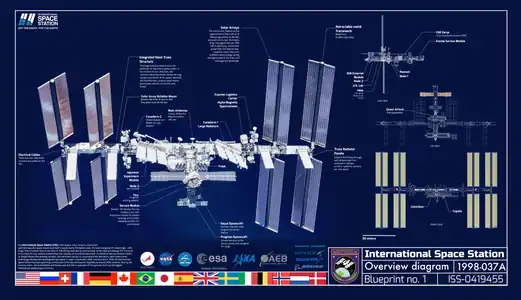The Atmospheric Waves Experiment (AWE) is a NASA instrument to be mounted on the exterior of the International Space Station (ISS) for the study of atmospheric gravity waves (not to be confused with astrophysical gravitational waves). AWE was built by the Utah State University Space Dynamics Laboratory, and the mission is led by Michael Taylor of Utah State University.[1] AWE was selected by NASA as an Explorers Program Mission of Opportunity in February 2019.[2][3] The SpaceX CRS-29 spacecraft carrying AWE is planned to be launched on 10 November 2023. Once at the ISS AWE will be extracted from the trunk section of the Cargo Dragon by the Dextre robotic arm, and will be attached to one of the station's Express Payload Adapter (ExPA), ELC-1 Site 3.[4] After two years of observation at the ISS, AWE will be removed form the station and jettisoned to space, where it will be disposed by reentering Earth's atmosphere to burn up.[5]
Mission
In Earth's atmosphere, differences in air density cause waves known as atmospheric gravity waves (AGWs). These AGWS are notable for traveling upward through the atmosphere carrying energy, eventually reaching space where they are hypothesized to affect the plasma environment surrounding Earth, or space weather. Space weather is known for causing interference in satellite and communication signals, including GPS navigation. Thus an understanding of AGWs and how it interacts with space weather may contribute to improving forecast of radio interference.[6]
When AGWs are in the realm of the atmosphere called the mesopause, they produce light, a phenomenon known as airglow. AWE will observe these airglow in infrared, with its location at the ISS allowing global coverage.[1]
Instrument
AWE will be NASA's first instrument dedicated for heliophysics on the ISS.[7] The AWE mission's hardware is the Advanced Mesospheric Temperature Mapper (AMTM), which consists of four identical radiometer telescopes assembly. Each telescope has a InGaAs detector array on its focal plane.[8]
References
- 1 2 "AWE Launching to Space Station to Study Atmospheric Waves via Airglow". NASA. October 25, 2023. Retrieved 2023-11-06.
- ↑ "NASA Selects Mission to Study Space Weather from Space Station". NASA. February 25, 2019. Retrieved 2023-11-06.
- ↑ Foust, Jeff (February 26, 2019). "NASA selects space weather experiment for ISS". SpaceNews. Retrieved 2023-11-06.
- ↑ "Magik Animation of Robotic Operations for Flight SpaceX-29 to ISS". NASA. September 8, 2023. Retrieved 2023-11-06.
- ↑ "AWE Atmospheric Waves Experiment". NASA Space Station Research Explorer. Retrieved 2023-11-06.
- ↑ "Science". AWE Mission. Retrieved 2023-11-06.
- ↑ "Atmospheric Waves Experiment (AWE) Calibration CALCON 2020". Utah State University. 2020. Retrieved 2023-11-07.
- ↑ "Atmospheric Waves Experiment (AWE) Advanced Mesospheric Temperature Mapper (AMTM) Flight Model Calibration Overview". Utah State University. 2023. Retrieved 2023-11-06.
External links
- Official website
- AWE website at nasa.gov

.png.webp)